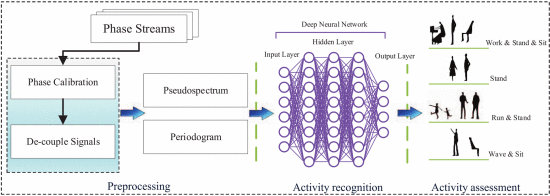Abstract
RFID-based human activity identification has become a key component in today's Internet-of-Things applications. State-of-the-art solutions mostly focus on the simple scenario with a single person in the open space. Extension to the more realistic realworld scenarios with multiple persons however is non-trivial. Given the much richer interactions among them, the backscattered signals will inevitably mixed, obscuring the information of individual activities. This is further complicated with multi-path in a common indoor environment. In this paper, we however argue that, though often considered harmful, the rich interactions combined with multi-path indeed offer more observable data. After careful processing the raw signals, critical information about the activities can be unveiled through modern learning tools. We present M 2 AI, which for the first time accommodates both multi-path and multi-object for activity identification. M 2 AI incorporates a phase calibration mechanism to automatically eliminate the frequency hopping offsets, and a novel decoupling mechanism for the periodogram and pseduospectrum in the raw signal mixture. The refined data are then fed into an advanced deep-learning engine that integrates a Convolutional Neural Network and a Long Short Term Memory network, which examines both spatial and temporal information in realtime for activity identification. Our M 2 AI is readily deployable using off-the-shelf RFID readers. We have implemented an M 2 AI prototype with Impinj UHF passive tags and a Speedway R420 reader. Experiments with multiple objects in a multipath-rich indoor environments report an activity identification accuracy of 97%, a significant gain (27%) over state-of-art solutions.
Author
Xiaoyi Fan; Feng Wang; Wei Gong; Lei Zhang; Jiangchuan Liu
Publication
IEEE ICDCS (CCF-B) [Link] [PDF]
Keywords
Indoor environments, Antennas, Machine learning, Tools, Calibration, RFID tags

